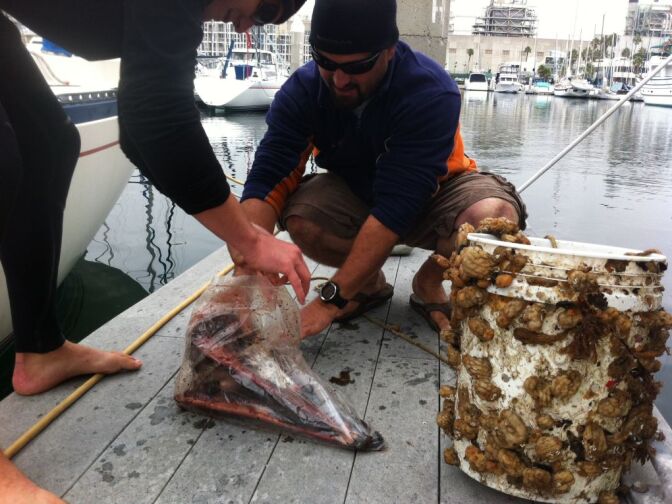Truth matters. Community matters. Your support makes both possible. LAist is one of the few places where news remains independent and free from political and corporate influence. Stand up for truth and for LAist. Make your year-end tax-deductible gift now.
This archival content was originally written for and published on KPCC.org. Keep in mind that links and images may no longer work — and references may be outdated.
Small aquariums can teach too, operators say
California is rich in big aquariums attached to accredited research institutions like Scripps in San Diego County or the Monterey Bay Aquarium up north. But, they're not the only places to learn about the sea. Piers along Santa Monica Bay are also home to smaller aquaria that local organizations operate.
One of the youngest of these, the Santa Monica Pier aquarium, is run by Heal the Bay.
There, Jose Bacallo, the senior aquarist for the Santa Monica Pier Aquarium stands on a slip in King Harbor. He pulls a plastic bag out of an Igloo cooler, balances it jauntily on his palm.
"We received the skull of a beaked dolphin," he says.
The skull will go into a big white bucket, then the whole thing, into the harbor. Bacallo gleefully describes maceration — the way waterborne bacteria will naturally remove skin and ligaments from the skull to make it exhibit-worthy.
"Over the next 6-7 months we're going to observe it and we're going to let the microorganisms and the bacteria of the ocean break it down so we can take it back to the aquarium and teach kids about this really beautiful dolphin."
Bacallo and fellow aquarist Seth Lawrence belong here. Their flip-flops are molded to their feet. Once a week they depart from here to gather algae and kelp in the bay as fresh produce for animals on exhibit.
Near one flat rock, jutting out from Palos Verdes, Seth Lawrence puts on a wetsuit and diving weights, ready to jump in for this week's harvest.
"We look for feather boa kelp, which adds a lot of great benefits to our tanks," he said. "It looks really great in there and it’s also enrichment for the animals. We'll also be collecting giant kelp today which we actually feed to a lot of our animals abalone and sea hares."
Bacallo and Lawrence are irreverent, but they also harbor great respect for their environment.
Bacallo says the bay is his backyard, "When I'm out here, or I'm in the water, doing stand up paddleboarding with my daughters, fishing, tidepooling, I've always viewed this as our resource."
"I've never looked at it as my right," he said. "I've always looked at it as, this is a resource for our greater community."
That's the way he wants visitors to the Santa Monica Pier Aquarium to experience it, too. All of its animals, plants, even the water comes from the bay. They're neighbors.
Piers in Hermosa and Manhattan Beach each host a small aquarium. The one at Santa Monica Pier is the trickiest to find: tucked underneath the boardwalk, among creosote-covered piers. But the aquarium's director, Vicki Wawerchak, says 80,000 people a year — especially locals — manage to find it.
"Some parents, we see them once a week, and they use this as kind of an extension of their house, you know," said Wawerchak.
This aquarium is an extension of the work of Heal the Bay, a 30-year-old Santa Monica-based environmental advocacy group. Someone’s deliberately placed a tank of moon jellyfish next to one of plastic trash.
"So moon jellies are these beautiful animals that float and drift in the water. The trash exhibit has a lot of our plastic bags, balloons, all this stuff that when it looks when it's floating in the water it looks just like a sea jelly. This is to show people that our garbage mimics what animals look like," Wawerchak said.
"People come to aquariums because they're going to believe us more than a scientist. It's almost like in a more easy way to digest. And so I think that's something we do really well. We take conservation education and advocacy to a different level."
Donations cover most of the operating costs. Retired teachers and teenagers who love science volunteer their time as peer educators. Wawerchak suggests adults pay at least $3 for entry. But she says the aquarium keeps admission low to draw more people through its doors.
Tanya Longmore came with friends and four kids under the age of 5. She and her Irish husband Martin came from Canada to see Disneyland and the Santa Monica pier. For her, the aquarium's a bonus.
"Someone on the pier had some jellyfish in a clear plastic container and we thought this is a great for the kids to come down and see it today," she said. Her husband was equally pleased, "The heat, the weather, the pier, I've never seen a pier like it. Fantastic."
Longmore and posse are still hard at work, and move past pier habitat, kelp forest, sandy bottom, and the rocky reef tank. Three-year-old Riley takes it all in:"I touched the starfish, a star fish. What happens when a starfish loses its leg? It turns into two starfishes."
It's not a huge room; the families move through it in an hour or so. Tthe kids run their hands over marine mammal artifacts like smooth skulls of sea lions and harbor seals before skipping back out into the sun.









